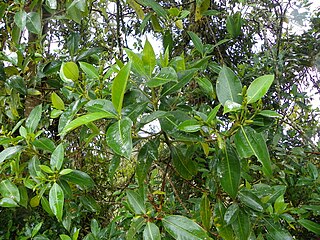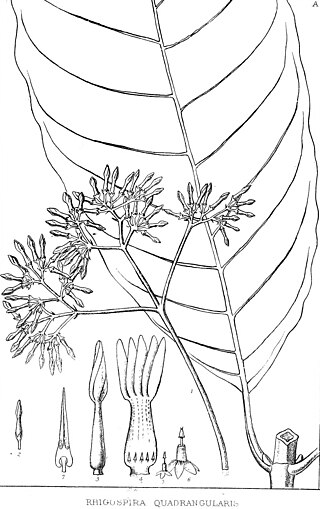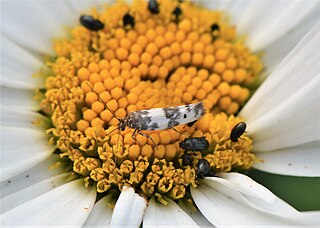
Melastomataceae is a family of dicotyledonous flowering plants found mostly in the tropics comprising c. 175 genera and c. 5115 known species. Melastomes are annual or perennial herbs, shrubs, or small trees.

Tibouchina is a neotropical flowering plant genus in the family Melastomataceae. Species of this genus are subshrubs, shrubs or small trees and typically have purple flowers. They are native to Mexico, the Caribbean, and South America where they are found as far south as northern Argentina. Members of this genus are known as glory bushes, glory trees or princess flowers. The name Tibouchina is adapted from a Guianan indigenous name for a member of this genus. A systematic study in 2013 showed that as then circumscribed the genus was paraphyletic, and in 2019 the genus was split into a more narrowly circumscribed Tibouchina, two re-established genera Pleroma and Chaetogastra, and a new genus, Andesanthus.

Carica is a genus of flowering plants in the family Caricaceae including the papaya, a widely cultivated fruit tree native to the American tropics.
Micrandra is a plant genus of the family Euphorbiaceae first described in 1854. It is native to South America.

Monochaetum is a neotropical genus of shrubs and subshrubs with about 54 species. It occurs in warm temperate to tropical montane habitats from Mexico and Central America to the South American Andes of Colombia, Venezuela, Ecuador and Peru with one species reaching the Guayana Highlands of Venezuela and Guyana.

Vasconcellea is a genus with 26 species of flowering plants in the family Caricaceae. Most were formerly treated in the genus Carica, but have been split out on genetic evidence. The genus name has also been incorrectly spelled "Vasconcella".

Sanchezia is a genus of the plant family Acanthaceae. It contains 45 species. Members of this genus are shrubs, rarely small trees or herbs, occurring in the lowlands of tropical South and Central America. A close relative is Suessenguthia, which looks quite similar.

Gustavia is a genus of flowering plants in the family Lecythidaceae described by Linnaeus in 1775. It is native to tropical Central America and South America. Many of the species are threatened; some are critically endangered Gustavia superba, though, is actually abundant in re-growing secondary forests. It grows in northern South America, from Panama south through the Andes as far as Ecuador, and along the Caribbean coast and in the Amazon basin. Gustavia flowers have numerous stamens, in some species as many as 1,200 in a single flower.

Hedyosmum is a genus of flowering plants in the family Chloranthaceae. There are about 40 to 45 species. They are distributed in Central and South America and the West Indies, and one species also occurs in southeastern Asia. They are mostly dioecious, except for H. nutans and H. brenesii which are exclusively monoecious, and H. scaberrimum and H. costaricense with both monoecious and dioecious individuals.
Julian Alfred Steyermark was a Venezuelan American botanist. His focus was on New World vegetation, and he specialized in the family Rubiaceae.

Leopoldinia is a mostly monoecious genus of flowering plant in the palm family from northern South America, where they are known as jará palm or pissava palm. The two known species are commercially important, especially L. piassaba, which yields sustenance and construction material. The genus is named for Maria Leopoldina, archduchess of Austria, and Brazilian empress.

Cymbiola is a genus of large predatory sea snail, a marine gastropod mollusk in the family Volutidae, the volutes.

Pleroma raddianum, synonyms including Pleroma pulchrum(Cham.) Triana and Tibouchina pulchra, is a plant species in the family Melastomataceae.

Macoubea is a genus of plant in the family Apocynaceae first described as a genus in 1775. It is native to South America and Central America.

Rhigospira is a genus of flowering plants in the family Apocynaceae, first described as a genus in 1878 by John Miers. The species, Rhigospira quadrangularis was first described as Ambelania quadrangularis by Johannes Müller Argoviensis in 1860 but was transferred to the genus, Rhigospira, in 1878 by John Miers. The genus contains only one known species, Rhigospira quadrangularis, native to northwestern South America.

Enolmis is a genus of moths in the family Scythrididae.

Acanthella is a genus of sponges in the family Dictyonellidae, which was first described in 1862 by Eduard Oscar Schmidt. The type species is Acanthella acuta Schmidt, 1862.
Merianthera is a genus of flowering plants belonging to the family Melastomataceae.

Andesanthus is a genus of flowering plant in the family Melastomataceae, native to Colombia, Costa Rica, Ecuador, Panama, Peru and Venezuela. The genus was established in 2019 for some species formerly placed in Tibouchina. Some species are cultivated as ornamental shrubs or trees.
Dalenia is a genus of flowering plants in family Melastomataceae. It includes nine species native to Borneo and New Guinea.















